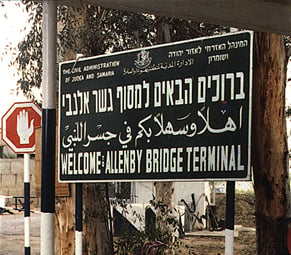After taking possession of the Gaza Strip and the West Bank during the war, Israeli officials were faced with a serious challenge: How to marginalize the fedayeen, or terrorists, in the West Bank and the Gaza Strip, who, because of their close proximity to Israel and the support they received from Arab countries furious at having lost the war, could wreak havoc on Israeli civilians. Instead of attacking the fedayeen head on, Israeli officials, under the leadership of Defense Minister Moshe Dayan, worked to keep, in the words of Mideast scholar Nadav Safran, a “low profile” in the occupied territories:
They kept their armed forces away from occupied areas, allow the continuation of the existing administration and personnel, supported the existing law and law enforcement agencies, rapidly removed curfews and other security restrictions, restored essential services disrupted by the war, and encouraged the local authorities to redress themselves to public welfare projects. (Israel: The Embattled Ally, Nadav Safran, 268)
In the years after the 1967 War, Israel invested heavily in the West Bank and the Gaza Strip, building hospitals, universities, public schools and new roads, improving the water supply and increasing the production of electricity available to the Palestinians.
Israeli officials also instituted the “Open Bridges policy” which, according to Safran, allowed the “free movement of people and goods back and forth across the Jordan River in order to avoid the disruption of previous trade relations and family and personal contacts.” Israel also allowed Arabs from the West Bank and Gaza Strip to visit Israel proper. Additionally, Israel allowed Arabs from throughout the world to visit relatives in the territories, which Safran notes “quickly brought in over 100,000 visitors annually.” Moreover, Arabs from the West Bank and the Gaza Strip were allowed to work in Israel “a step that initiated a revolution in the life of the areas and their inhabitants.” (Safran, 267-68)

The Allenby Bridge between the West Bank and Jordan
Although this free movement didn’t necessarily endear Israel to Palestinians and made it easier for the Arab world to support Palestinian terrorists, it did allow residents of the West Bank and Gaza strip to generate substantial economic growth. According to the World Bank, the real per capita Gross National Product (GNP) in the occupied territories more than doubled between 1970 and 1980, making it the fourth fastest growing economy in the world. In 1993, the World Bank reported:
The economy of the [occupied territories] grew rapidly between 1968 and 1980 (average annual increase of 7% and 9 percent in real per capita GDP and GNP respectively), triggered by a number of factors, including the rapid integration with Israel and the regional economic boom. In the early years of the occupation, there was a sharp expansion in the employment of unskilled Palestinian labor in Israel and a rise in incomes, which in turn spurred domestic economic activity, especially in the construction sector. Earnings of Palestinian workers in Israel rose from negligible levels in 1968 to almost one quarter of GNP in 1975.
According to the World Bank, economic growth in the disputed territories continued even as Israel experienced an economic slowdown in the mid-1970s as many Palestinians were able to find work in other countries in the Middle East:
Since unskilled labor played a central role in the growth, the poor shared in this growth, and as a result, in all likelihood, there was a significant reduction in poverty in this period. Household conditions improved substantially, with a several-fold rise in the possession of consumer durables and significant increases in access to municipal water and electricity connections. Life expectancy increased by a decade, and there was significant progress in reducing infant mortality. School enrollments also rose during this time. These advances mirrored substantial improvements in income levels and in living conditions all through the region during the 1970s.
Economic decline followed the onset of the Intifada which began in December 1987. The Palestinian economy suffered another blow after the first Gulf War, which disrupted the economies of the Gulf Region, where many Palestinians found work. (Palestinian support for Saddam Hussein’s invasion of Kuwait resulted in many Palestinians being forced from that country after the war.)
Just as Palestinians living in the West Bank and the Gaza Strip enjoyed substantial increases in well-being under Israeli rule before the Intifada shattered economic relations between Israel and Palestinians, the increase in living standards for Palestinians in the 1990s was set back sharply as a result of the terror war launched against Israel in 2000.

